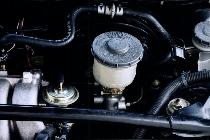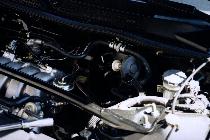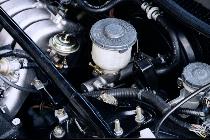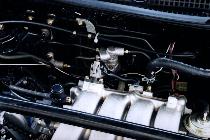Master Cylinder
Following the rear brake swap, the feel of the brakes wasn't too reassuring.
This was due to the stock 13/16" master cylinder, which meant that the
brake pedal had to travel further for the same braking effect. So, as a
solution to this problem, I opted to swap in the 1" master cylinder and booster
assembly from a GSR, which I got together with the brake swap parts.
 The
main problem here was the brake line piping. The stock Civic master cylinder
has two brake lines coming out of the driver's side (left side) of the
master cylinder. On the other hand, the GSR master cylinder had a different
layout. The outlet at the end of the master cylinder was in the right place,
but the second one in the middle of the cylinder was on the "wrong" side.
To make matters worse, this fitting has a different thread size, but thankfully
the flare nut was already there. All I had to do was to bend the existing
pipe and replace the fitting. The
main problem here was the brake line piping. The stock Civic master cylinder
has two brake lines coming out of the driver's side (left side) of the
master cylinder. On the other hand, the GSR master cylinder had a different
layout. The outlet at the end of the master cylinder was in the right place,
but the second one in the middle of the cylinder was on the "wrong" side.
To make matters worse, this fitting has a different thread size, but thankfully
the flare nut was already there. All I had to do was to bend the existing
pipe and replace the fitting.
Foreseeing problems, I went to the wreckers and pulled a brake line off
a wrecked 93 Integra. And since I was there, I figured I'd pull the proportioning
valve too. More about that later. Then it was off to Checker's to buy a
pipe flaring tool and a pipe cutter for about $12. Sitting on my toolbox,
I practiced cutting and flaring the old brake lines until I got the hang
of it.

If only everything were that simple. I proceeded to dismantle the existing
brake cylinder and hoped the GSR master cylinder would fit on the stock
booster. No such luck, so out came the brake booster. I was ready to put
the new booster in, or at least that was what I thought.
With the huge B18C motor and it's large intake plenum and runners there
was no space to move the big GSR brake booster into position. The main
problem was the large IAB vacuum dashpot on the B18C runner. Secondly,
the part of the booster that connected to the brake pedal stuck out too
much. So, the IAB dashpot was removed and using my body weight, I pushed
in the booster fully and clamped the end that came out the rear side with
a pair of Vise Grips. Still, it took some tricky maneuvering to finally
get the booster in and was promptly bolted up.

Next was the new master cylinder. It went in without problems. Everything
seemed to work right for now. The end of the brake line fit right in, so that was
good. Gently I bent the second brake line upright and cut off about 1/2"
of the piping to get the smaller fitting out and plopped the larger fitting
in its place. With the pipe sticking upright, it was difficult to flare
the pipe even with all that practice. After three tries, it looked
good, and I proceeded to bend and connect it to the second outlet on the
master cylinder. When everything was done it looked beautiful (even if I
say so myself) and was pretty stock looking.
Proportioning Valve
Since the stock proportioning valve did upset the balance of the new brake
setup, I decided to go for it and use a proportioning valve off one of
Honda's 4-disk setups. Comparing all the proportioning valves, they all
looked the same but had different numbers stamped on them. Stock 2-disk,
2-drum setups had a "3030" stamped onto the valve while the 4-disk Integras,
regardless of year, had "4040" on them. So you know which ones to
look for now.
Removing the stock proportioning valve was pretty straightforward, but
the pipes had to be bent a little because they reached in pretty deep into the valve (about1/2"). The proportioning valves can not be disassembled
because a special bolts is used to bolt it together, and also to the
mounting bracket. Looking at the new proportioning valve, only one bolt
hole lined up on the mounting bracket. There was no choice except to use
that one.
 
Even though the valves were physically the same, it more wrestling to
get the lines attached correctly and to get them bolted in right. But when
everything was done, the new valve was very secure, despite the fact that
it was only held by one bolt. It had 6 metal brake lines supporting it
though so I guess it's secure enough.
Finishing Up
Starting at the master cylinder, the entire brake system was bled and flushed
joint by joint to make sure no air was trapped in the lines. Finally
the brakes were bled again at the ends just to be sure and everything seemed
to work fine. The vacuum boost line was then reattached to the booster
and everything was ready for a test drive.
The effects of the brake swap was very obvious after the master cylinder
and proportioning valve were changed and the brakes are now VERY responsive.
The car now stops on a dime. The next step is to put in the front GSR brake
calipers! |
